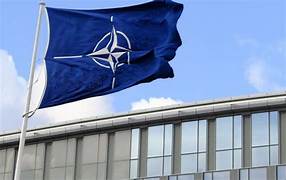Interior ministers from six NATO countries have agreed to establish a unified “drone wall” defense system along their borders with Russia and Belarus. In tandem with this decision, Lithuania’s parliament has recently committed to increasing military spending to 3% of GDP. This commitment aligns with NATO’s objective for member states to allocate at least 2% of their GDP to defense, a target that many nations have yet to achieve. The NATO fund has seen an increase due to the Russia-Ukraine conflict, further supporting its resources. NATO’s primary objective is to defend its borders while securing the necessary armaments and munitions to counter potential threats from Russia. However, the organization has faced challenges in achieving this goal.
Russia has criticized NATO’s actions, accusing them of exacerbating and prolonging the conflict. Not all NATO countries are providing military support to Ukraine, as some are refraining from escalating tensions due to economic and military constraints.
NATO’s recent endeavors to bolster its borders, particularly along its eastern flank, stem from various factors linked to the ongoing conflict in Ukraine and broader security apprehensions. One key motivation is the need for deterrence against Russia, whose invasion of Ukraine has significantly escalated tensions with NATO. Strengthening border defenses is perceived as a strategy to dissuade potential Russian aggression, particularly against NATO member states bordering Russia or closely allied nations like Belarus.
Additionally, heightened Russian military activities near NATO borders, including large-scale military exercises and troop deployments, have raised apprehensions about potential threats.
Moreover, NATO’s commitment to collective defense principles underpins its fortification initiatives. According to this principle, an attack on one member state is considered an attack on all, necessitating a robust response from the alliance. Strengthening border defenses enhances NATO’s capacity to effectively counter any potential aggression.
Furthermore, the fortification efforts serve to reassure Eastern European member states, particularly those sharing borders with Russia or Belarus, which have expressed concerns about potential Russian aggression..
Beyond conventional military threats, NATO is also cognizant of the challenges posed by hybrid threats, such as cyberattacks and disinformation campaigns. Accordingly, fortification efforts may encompass measures aimed at addressing these broader security challenges.
Interior ministers from six NATO countries have agreed to establish a collective “drone wall” defense system along their borders adjoining Russia and Belarus. The decision was reached during a meeting convened in Riga, attended by officials from Latvia, Lithuania, Estonia, Poland, Finland, and Norway. This joint effort seeks to strengthen regional security and counter perceived threats emanating from Moscow and Minsk. During the discussions, Lithuanian Interior Minister Agne Bilotaite emphasized the pressing need for this project. Bilotaite accused Russia and Belarus of engaging in activities aimed at undermining internal security and public order within the region.
The proposed “drone wall” is slated to span from Norway to Poland and will integrate various components such as physical infrastructure, surveillance systems, drones, and advanced technologies. Bilotaite also proposed conducting joint mass evacuation drills at a regional level to enhance preparedness for potential crises. Despite Norway’s non-membership in the European Union, the ministers explored options for securing EU funding to support the defense efforts.
Additionally, Lithuania’s parliament has recently committed to increasing military spending to 3% of GDP, aligning with NATO’s directive for member states to allocate at least 2% of their GDP to defense.
NATO Secretary-General Jens Stoltenberg disclosed plans to supply one million drones to Ukraine, urging member states to escalate armament production to meet this objective.
However, Moscow has cautioned that Western arms deliveries could prolong the conflict in Ukraine. Russia perceives NATO’s encroachment towards its borders as a fundamental threat to its security. Russian President Vladimir Putin has explicitly stated that Russia harbors no intentions of attacking NATO. He dismissed Western allegations of Russian aggression.
